ECU TOYOTA AURIS 2012 (in English) User Guide
[x] Cancel search | Manufacturer: TOYOTA, Model Year: 2012, Model line: AURIS, Model: TOYOTA AURIS 2012Pages: 750, PDF Size: 20.05 MB
Page 51 of 750
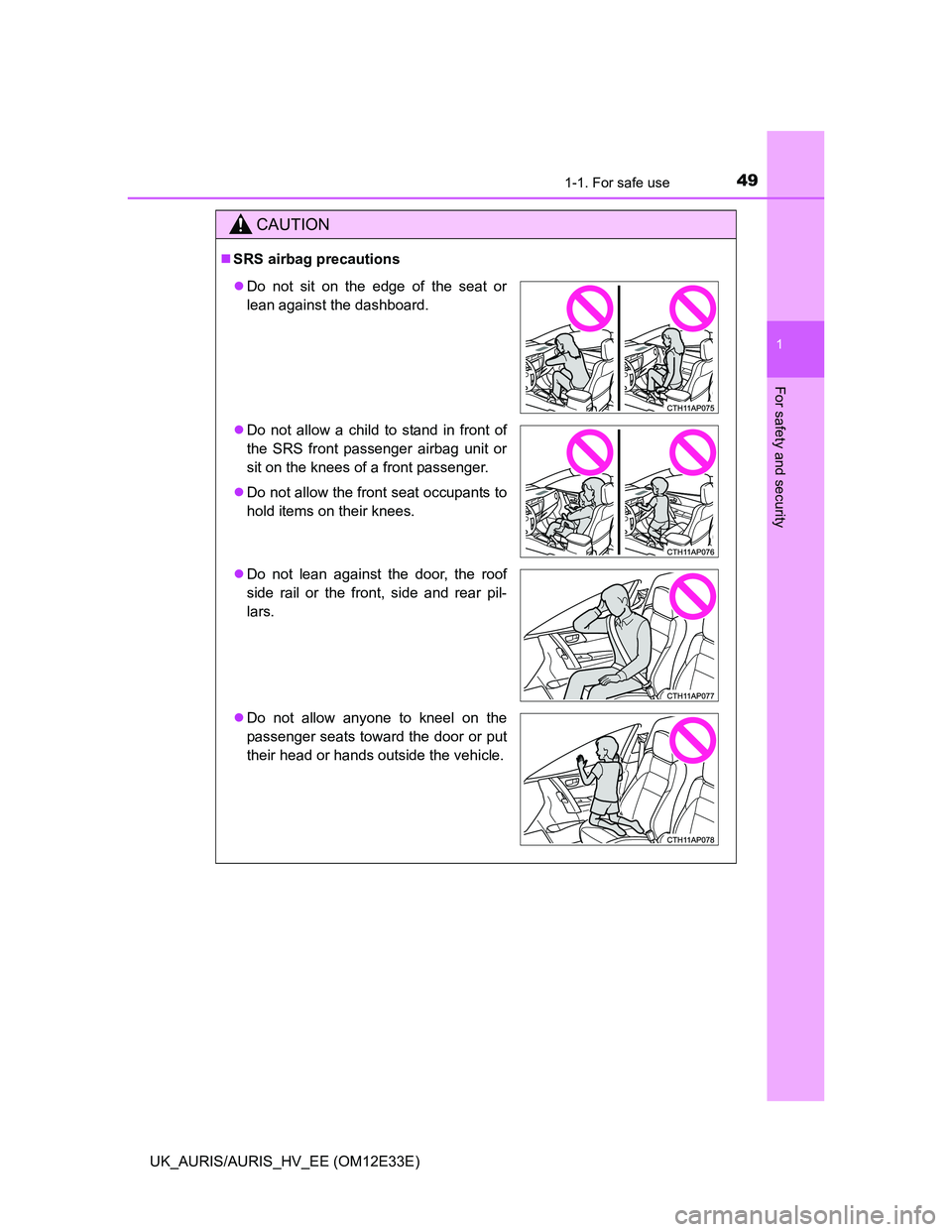
491-1. For safe use
1
For safety and security
UK_AURIS/AURIS_HV_EE (OM12E33E)
CAUTION
SRS airbag precautions
Do not sit on the edge of the seat or
lean against the dashboard.
Do not allow a child to stand in front of
the SRS front passenger airbag unit or
sit on the knees of a front passenger.
Do not allow the front seat occupants to
hold items on their knees.
Do not lean against the door, the roof
side rail or the front, side and rear pil-
lars.
Do not allow anyone to kneel on the
passenger seats toward the door or put
their head or hands outside the vehicle.
Page 53 of 750
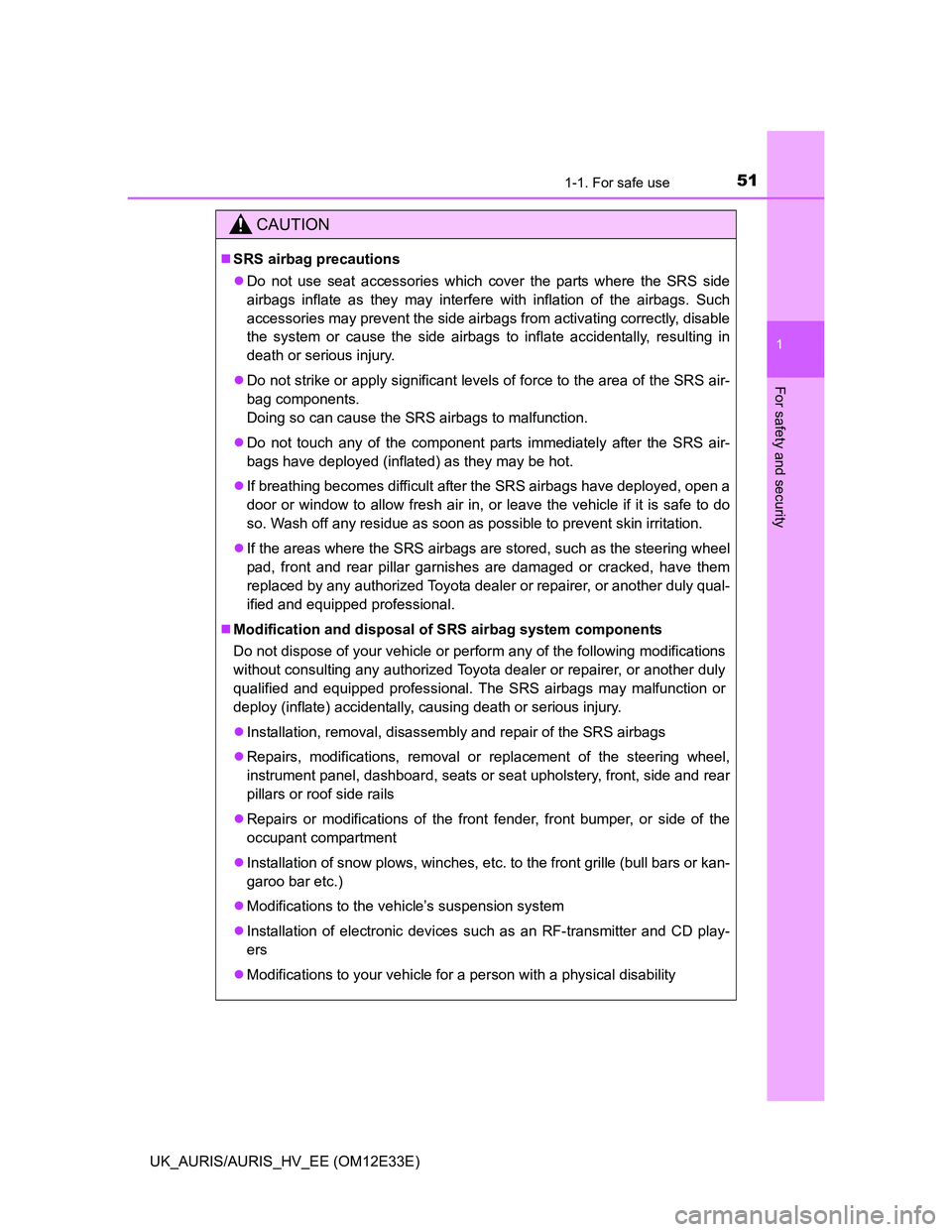
511-1. For safe use
1
For safety and security
UK_AURIS/AURIS_HV_EE (OM12E33E)
CAUTION
SRS airbag precautions
Do not use seat accessories which cover the parts where the SRS side
airbags inflate as they may interfere with inflation of the airbags. Such
accessories may prevent the side airbags from activating correctly, disable
the system or cause the side airbags to inflate accidentally, resulting in
death or serious injury.
Do not strike or apply significant levels of force to the area of the SRS air-
bag components.
Doing so can cause the SRS airbags to malfunction.
Do not touch any of the component parts immediately after the SRS air-
bags have deployed (inflated) as they may be hot.
If breathing becomes difficult after the SRS airbags have deployed, open a
door or window to allow fresh air in, or leave the vehicle if it is safe to do
so. Wash off any residue as soon as possible to prevent skin irritation.
If the areas where the SRS airbags are stored, such as the steering wheel
pad, front and rear pillar garnishes are damaged or cracked, have them
replaced by any authorized Toyota dealer or repairer, or another duly qual-
ified and equipped professional.
Modification and disposal of SRS airbag system components
Do not dispose of your vehicle or perform any of the following modifications
without consulting any authorized Toyota dealer or repairer, or another duly
qualified and equipped professional. The SRS airbags may malfunction or
deploy (inflate) accidentally, causing death or serious injury.
Installation, removal, disassembly and repair of the SRS airbags
Repairs, modifications, removal or replacement of the steering wheel,
instrument panel, dashboard, seats or seat upholstery, front, side and rear
pillars or roof side rails
Repairs or modifications of the front fender, front bumper, or side of the
occupant compartment
Installation of snow plows, winches, etc. to the front grille (bull bars or kan-
garoo bar etc.)
Modifications to the vehicle’s suspension system
Installation of electronic devices such as an RF-transmitter and CD play-
ers
Modifications to your vehicle for a person with a physical disability
Page 55 of 750
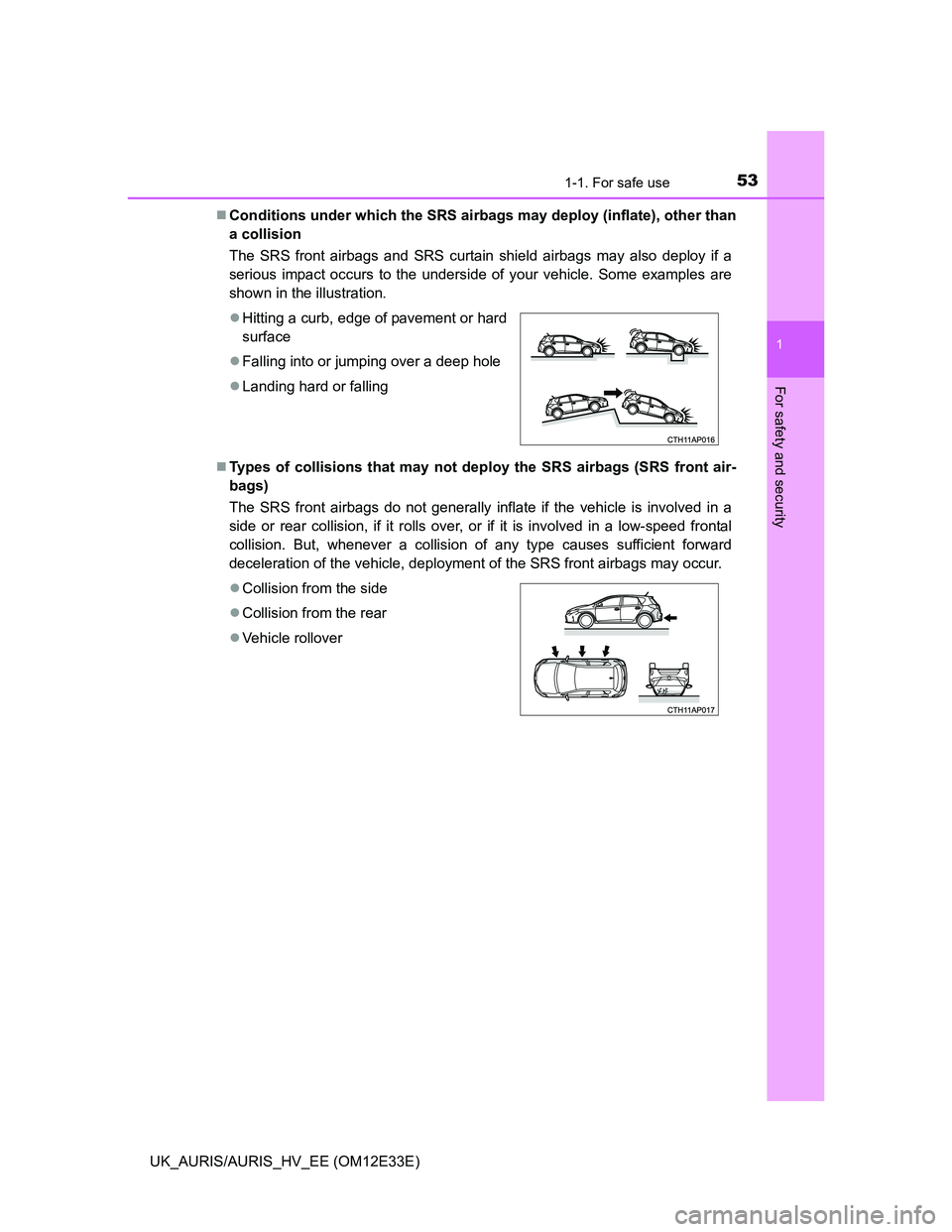
531-1. For safe use
1
For safety and security
UK_AURIS/AURIS_HV_EE (OM12E33E)Conditions under which the SRS airbags may deploy (inflate), other than
a collision
The SRS front airbags and SRS curtain shield airbags may also deploy if a
serious impact occurs to the underside of your vehicle. Some examples are
shown in the illustration.
Types of collisions that may not deploy the SRS airbags (SRS front air-
bags)
The SRS front airbags do not generally inflate if the vehicle is involved in a
side or rear collision, if it rolls over, or if it is involved in a low-speed frontal
collision. But, whenever a collision of any type causes sufficient forward
deceleration of the vehicle, deployment of the SRS front airbags may occur. Hitting a curb, edge of pavement or hard
surface
Falling into or jumping over a deep hole
Landing hard or falling
Collision from the side
Collision from the rear
Vehicle rollover
Page 57 of 750
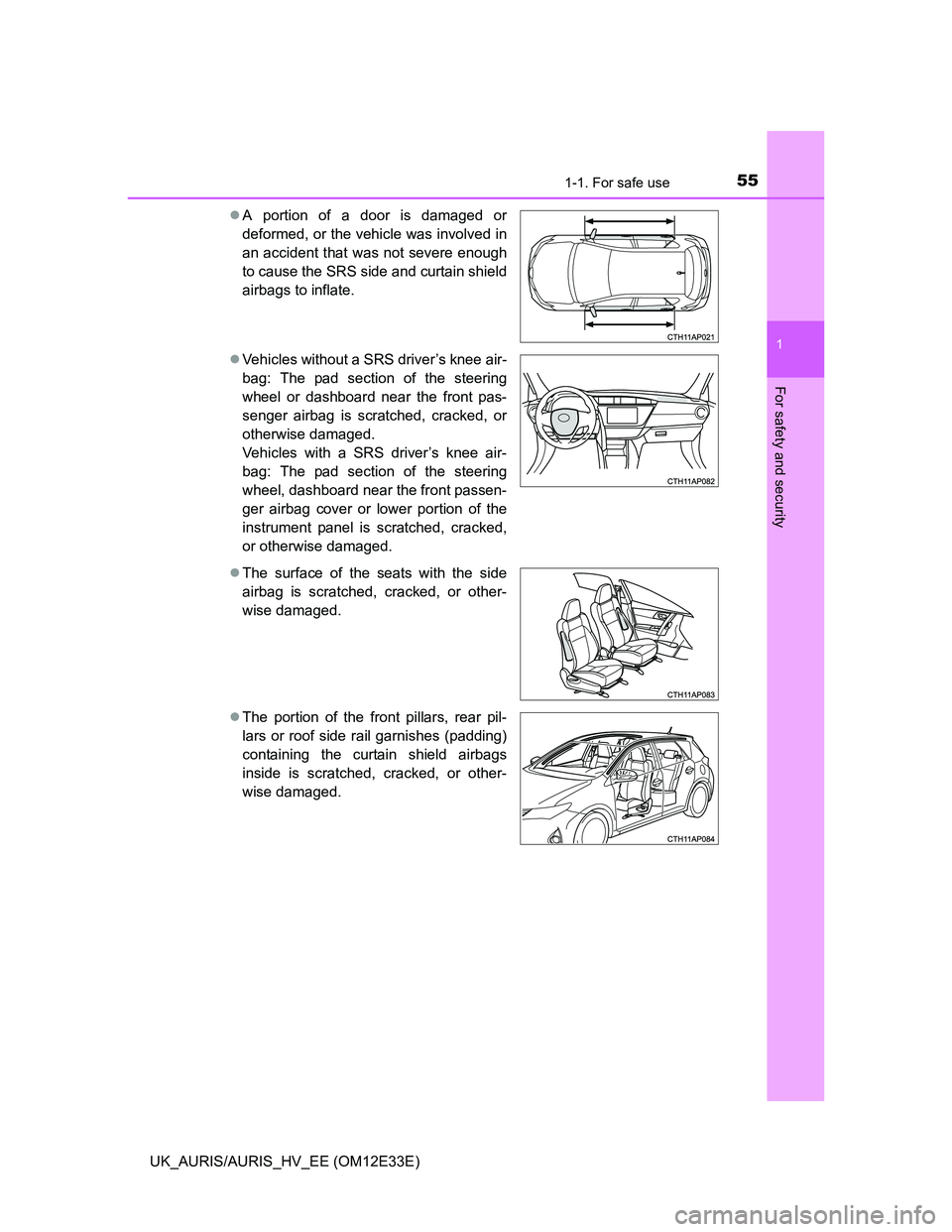
551-1. For safe use
1
For safety and security
UK_AURIS/AURIS_HV_EE (OM12E33E)A portion of a door is damaged or
deformed, or the vehicle was involved in
an accident that was not severe enough
to cause the SRS side and curtain shield
airbags to inflate.
Vehicles without a SRS driver’s knee air-
bag: The pad section of the steering
wheel or dashboard near the front pas-
senger airbag is scratched, cracked, or
otherwise damaged.
Vehicles with a SRS driver’s knee air-
bag: The pad section of the steering
wheel, dashboard near the front passen-
ger airbag cover or lower portion of the
instrument panel is scratched, cracked,
or otherwise damaged.
The surface of the seats with the side
airbag is scratched, cracked, or other-
wise damaged.
The portion of the front pillars, rear pil-
lars or roof side rail garnishes (padding)
containing the curtain shield airbags
inside is scratched, cracked, or other-
wise damaged.
Page 59 of 750
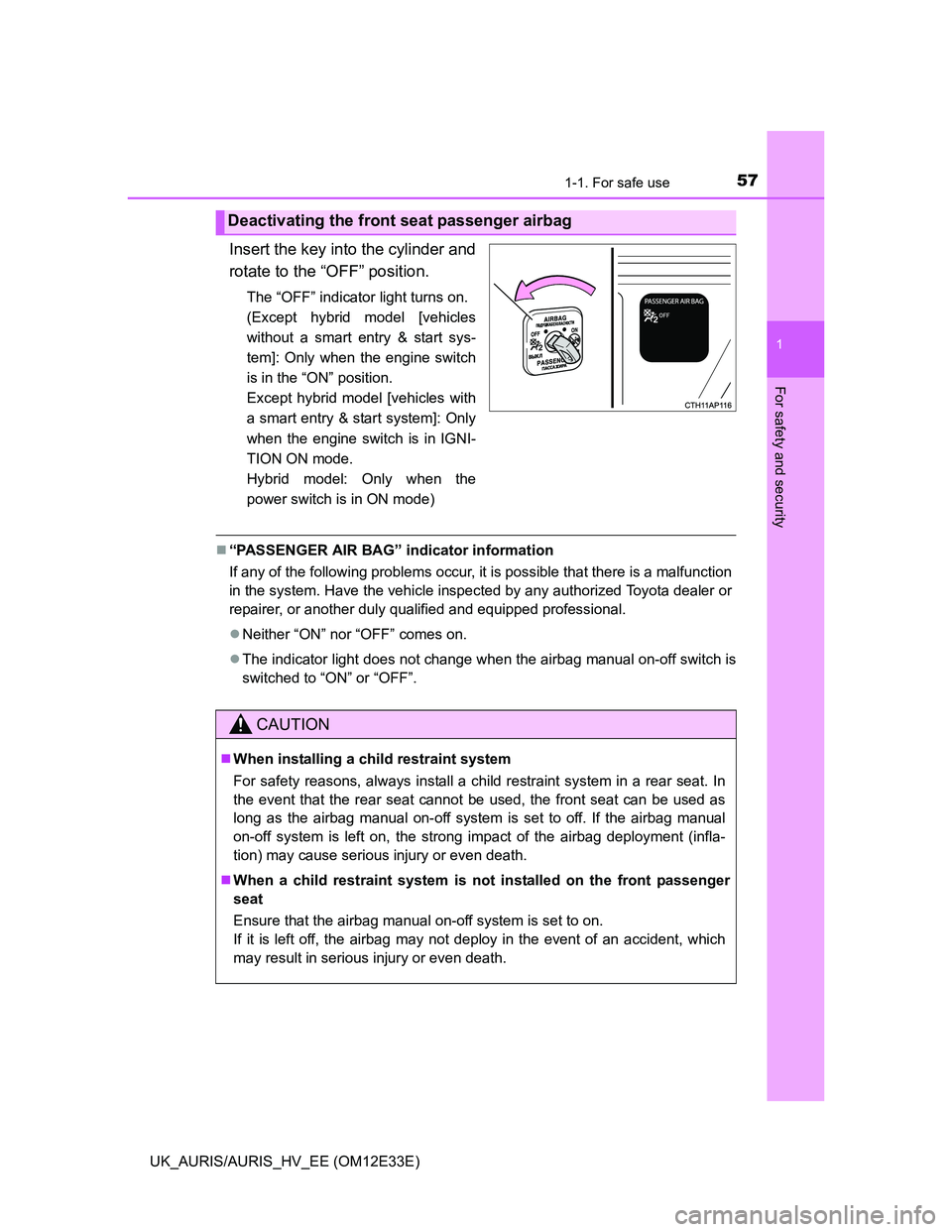
571-1. For safe use
1
For safety and security
UK_AURIS/AURIS_HV_EE (OM12E33E)
Insert the key into the cylinder and
rotate to the “OFF” position.
The “OFF” indicator light turns on.
(Except hybrid model [vehicles
without a smart entry & start sys-
tem]: Only when the engine switch
is in the “ON” position.
Except hybrid model [vehicles with
a smart entry & start system]: Only
when the engine switch is in IGNI-
TION ON mode.
Hybrid model: Only when the
power switch is in ON mode)
“PASSENGER AIR BAG” indicator information
If any of the following problems occur, it is possible that there is a malfunction
in the system. Have the vehicle inspected by any authorized Toyota dealer or
repairer, or another duly qualified and equipped professional.
Neither “ON” nor “OFF” comes on.
The indicator light does not change when the airbag manual on-off switch is
switched to “ON” or “OFF”.
Deactivating the front seat passenger airbag
CAUTION
When installing a child restraint system
For safety reasons, always install a child restraint system in a rear seat. In
the event that the rear seat cannot be used, the front seat can be used as
long as the airbag manual on-off system is set to off. If the airbag manual
on-off system is left on, the strong impact of the airbag deployment (infla-
tion) may cause serious injury or even death.
When a child restraint system is not installed on the front passenger
seat
Ensure that the airbag manual on-off system is set to on.
If it is left off, the airbag may not deploy in the event of an accident, which
may result in serious injury or even death.
Page 61 of 750
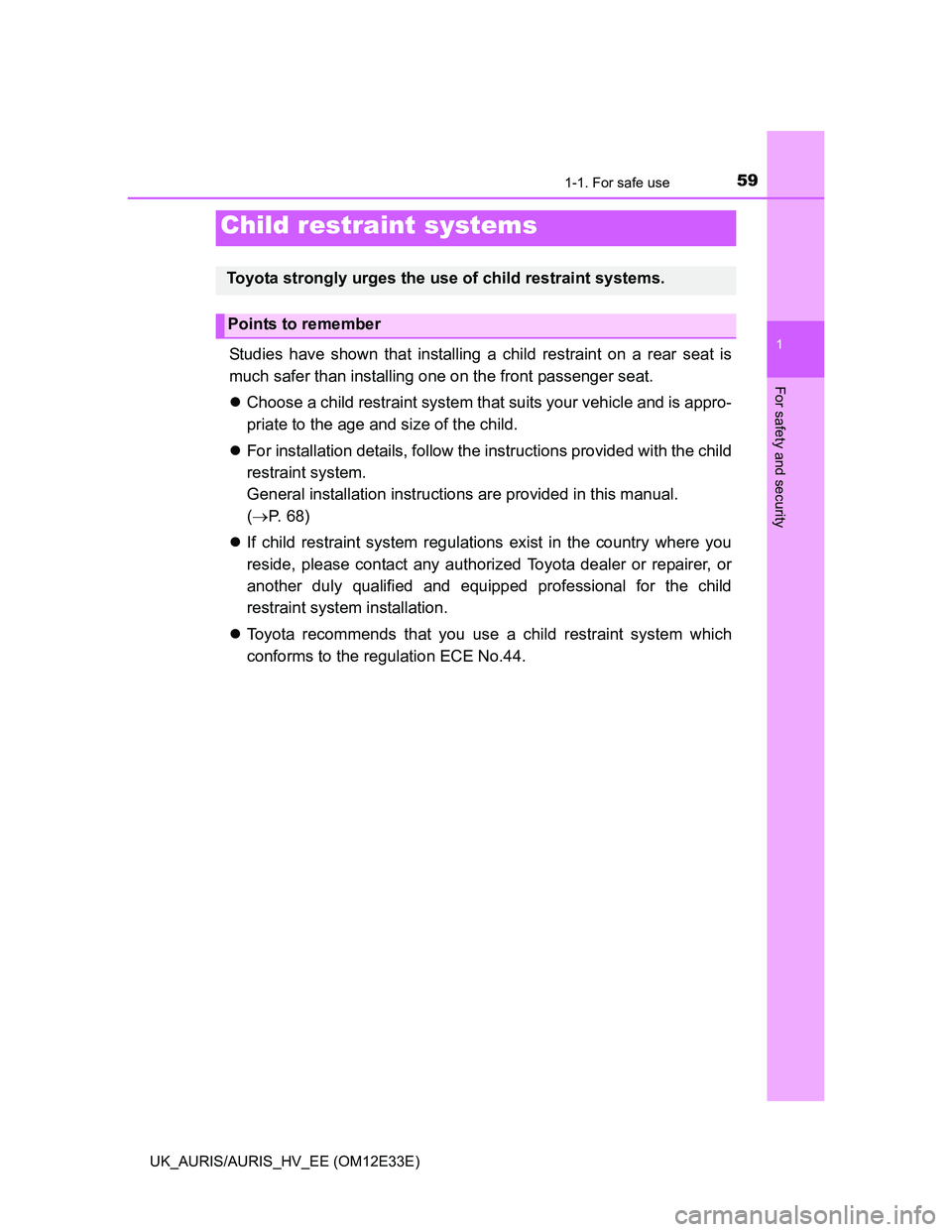
591-1. For safe use
1
For safety and security
UK_AURIS/AURIS_HV_EE (OM12E33E)
Studies have shown that installing a child restraint on a rear seat is
much safer than installing one on the front passenger seat.
Choose a child restraint system that suits your vehicle and is appro-
priate to the age and size of the child.
For installation details, follow the instructions provided with the child
restraint system.
General installation instructions are provided in this manual.
(P. 68)
If child restraint system regulations exist in the country where you
reside, please contact any authorized Toyota dealer or repairer, or
another duly qualified and equipped professional for the child
restraint system installation.
Toyota recommends that you use a child restraint system which
conforms to the regulation ECE No.44.
Child restraint systems
Toyota strongly urges the use of child restraint systems.
Points to remember
Page 62 of 750
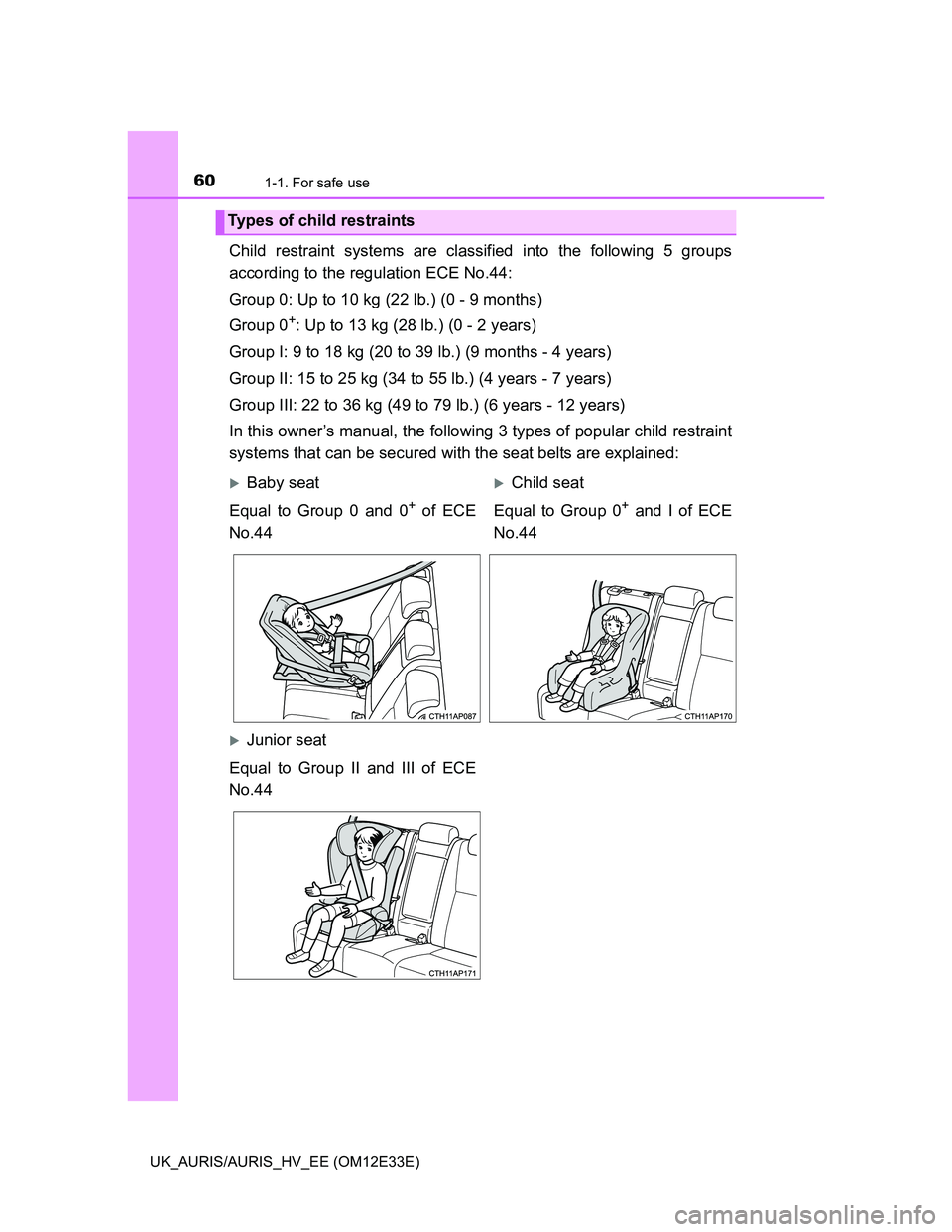
601-1. For safe use
UK_AURIS/AURIS_HV_EE (OM12E33E)
Child restraint systems are classified into the following 5 groups
according to the regulation ECE No.44:
Group 0: Up to 10 kg (22 lb.) (0 - 9 months)
Group 0
+: Up to 13 kg (28 lb.) (0 - 2 years)
Group I: 9 to 18 kg (20 to 39 lb.) (9 months - 4 years)
Group II: 15 to 25 kg (34 to 55 lb.) (4 years - 7 years)
Group III: 22 to 36 kg (49 to 79 lb.) (6 years - 12 years)
In this owner’s manual, the following 3 types of popular child restraint
systems that can be secured with the seat belts are explained:
Types of child restraints
Baby seatChild seat
Equal to Group 0 and 0
+ of ECE
No.44Equal to Group 0+ and I of ECE
No.44
Junior seat
Equal to Group II and III of ECE
No.44
Page 63 of 750
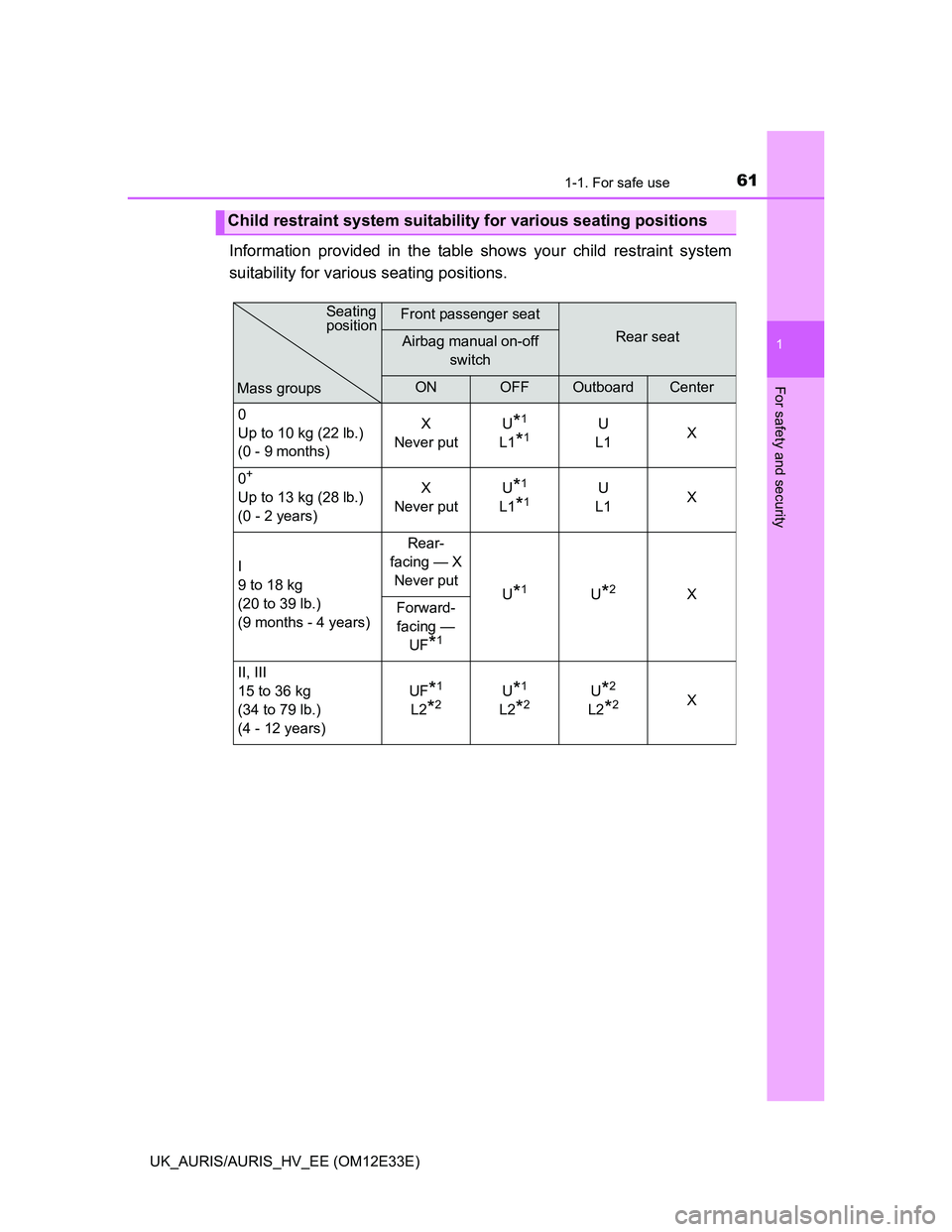
611-1. For safe use
1
For safety and security
UK_AURIS/AURIS_HV_EE (OM12E33E)
Information provided in the table shows your child restraint system
suitability for various seating positions.
Child restraint system suitability for various seating positions
Front passenger seat
Rear seatAirbag manual on-off
switch
ONOFFOutboardCenter
0
Up to 10 kg (22 lb.)
(0 - 9 months)X
Never putU
*1
L1*1U
L1X
0
+
Up to 13 kg (28 lb.)
(0 - 2 years)X
Never putU*1
L1*1U
L1X
I
9 to 18 kg
(20 to 39 lb.)
(9 months - 4 years)Rear-
facing — X
Never put
U
*1U*2X
Forward-
facing —
UF
*1
II, III
15 to 36 kg
(34 to 79 lb.)
(4 - 12 years)UF
*1
L2*2U*1
L2*2U*2
L2*2X
Mass groupsSeating
position
Page 65 of 750
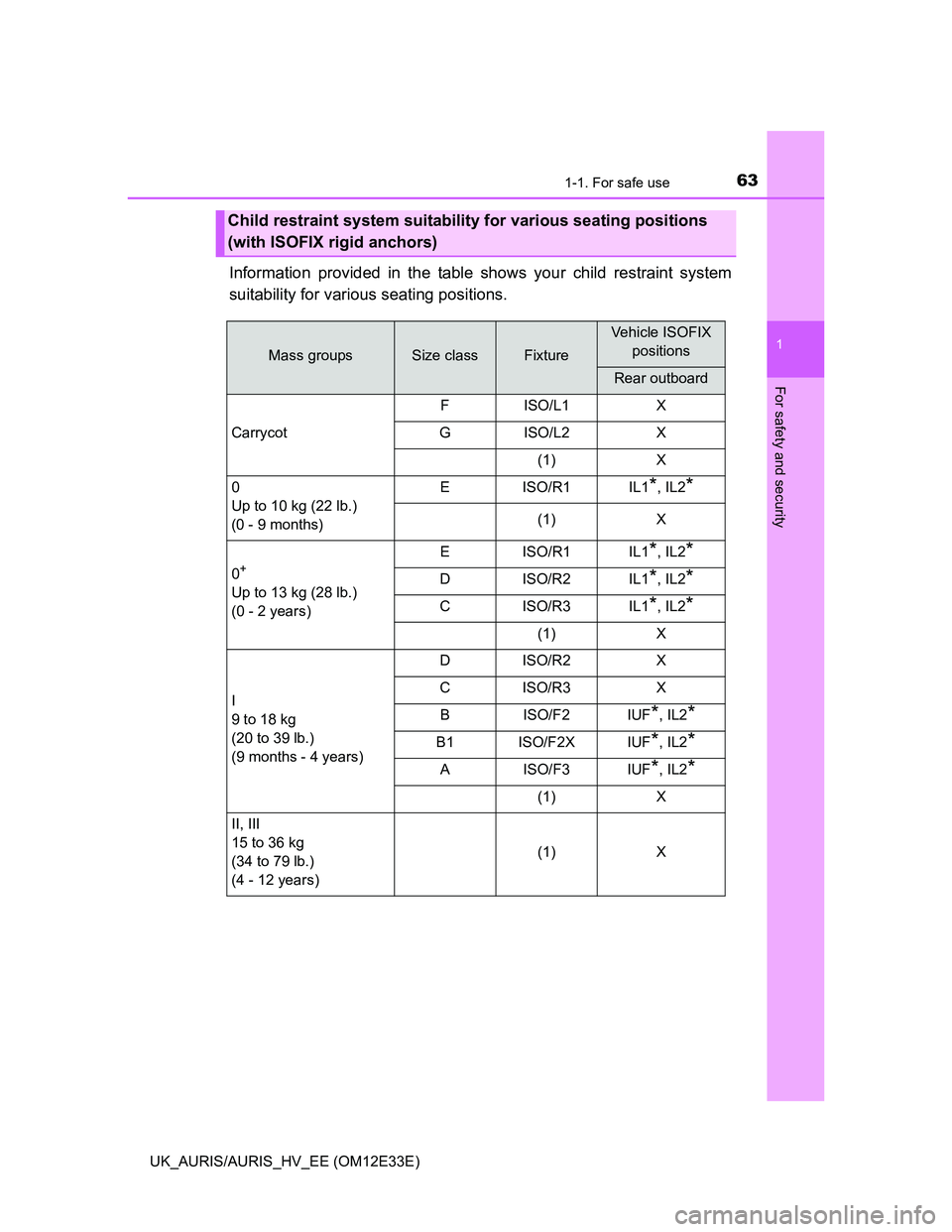
631-1. For safe use
1
For safety and security
UK_AURIS/AURIS_HV_EE (OM12E33E)
Information provided in the table shows your child restraint system
suitability for various seating positions.
Child restraint system suitability for various seating positions
(with ISOFIX rigid anchors)
Mass groupsSize classFixture
Vehicle ISOFIX
positions
Rear outboard
CarrycotF ISO/L1 X
G ISO/L2 X
(1) X
0
Up to 10 kg (22 lb.)
(0 - 9 months)EISO/R1IL1
*, IL2*
(1) X
0
+
Up to 13 kg (28 lb.)
(0 - 2 years)EISO/R1IL1
*, IL2*
DISO/R2IL1*, IL2*
CISO/R3IL1*, IL2*
(1) X
I
9 to 18 kg
(20 to 39 lb.)
(9 months - 4 years)DISO/R2 X
CISO/R3 X
BISO/F2IUF
*, IL2*
B1 ISO/F2X IUF*, IL2*
AISO/F3IUF*, IL2*
(1) X
II, III
15 to 36 kg
(34 to 79 lb.)
(4 - 12 years)(1) X
Page 67 of 750
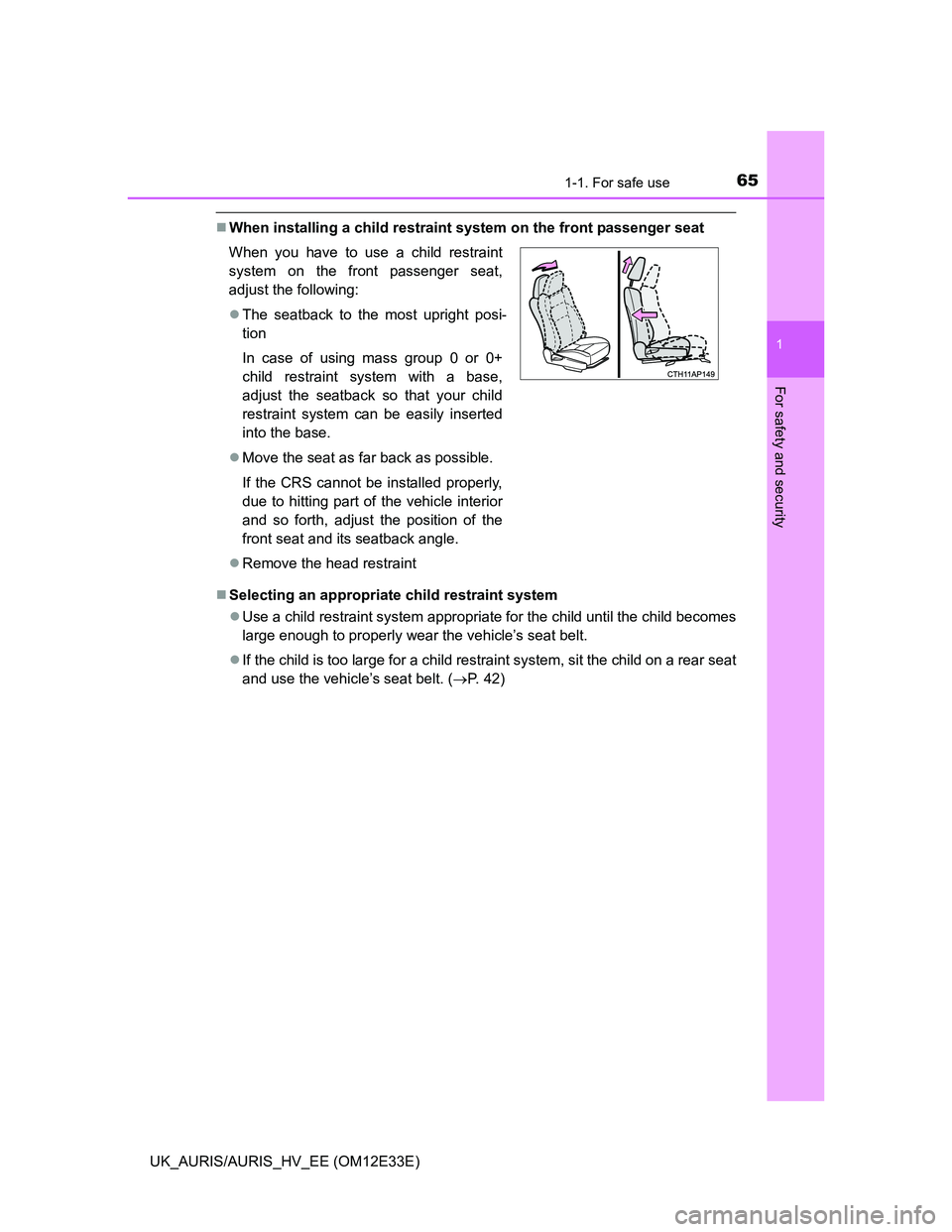
651-1. For safe use
1
For safety and security
UK_AURIS/AURIS_HV_EE (OM12E33E)
When installing a child restraint system on the front passenger seat
Selecting an appropriate child restraint system
Use a child restraint system appropriate for the child until the child becomes
large enough to properly wear the vehicle’s seat belt.
If the child is too large for a child restraint system, sit the child on a rear seat
and use the vehicle’s seat belt. (P. 42) When you have to use a child restraint
system on the front passenger seat,
adjust the following:
The seatback to the most upright posi-
tion
In case of using mass group 0 or 0+
child restraint system with a base,
adjust the seatback so that your child
restraint system can be easily inserted
into the base.
Move the seat as far back as possible.
If the CRS cannot be installed properly,
due to hitting part of the vehicle interior
and so forth, adjust the position of the
front seat and its seatback angle.
Remove the head restraint